Putting Technique Explained: Posture, Stroke And Strike Tips
The putting technique is something many amateurs neglect when practicing, but it has a huge impact on your scores. These tips will help you putt like a pro...
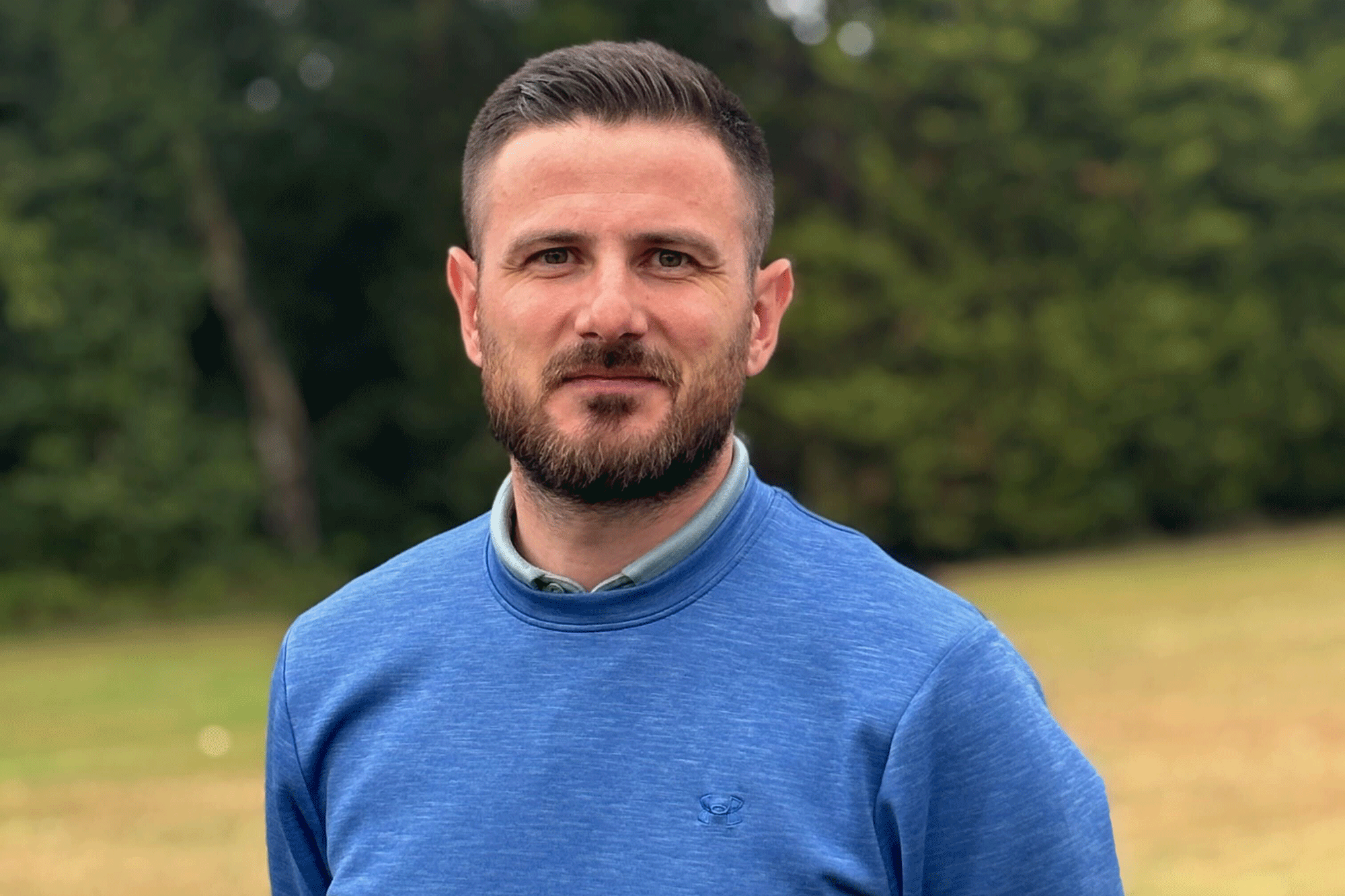

Mastering the correct putting technique will not only help you to sink more putts, it will also give you confidence on the greens and help you to shoot lower scores.
All the best putting tips will tell you that in order to improve your performances on the greens you need to master three key areas - how to read greens, how to control distance and the often neglected member of the trio - how to practice putting effectively.
In this article, two of our top Golf Monthly Top 50 Coaches, Alex Elliott and Neil Plimmer, share their expert advice on how to perfect your putting technique...
The Quick Tips: Step-By-Step Guide
- Tuck your elbows in to your side, with tricep and bicep touching rib cage throughout swing
- Let you arms hang down naturally before gripping the putter
- Ensure palms are facing when gripping the putter
- Ball position should be one putter grip width ahead of sternum to hit up on the ball
- Use practice putting drills, like the ones below, to improve your distance control
Alex Elliott: Putting Technique Tips
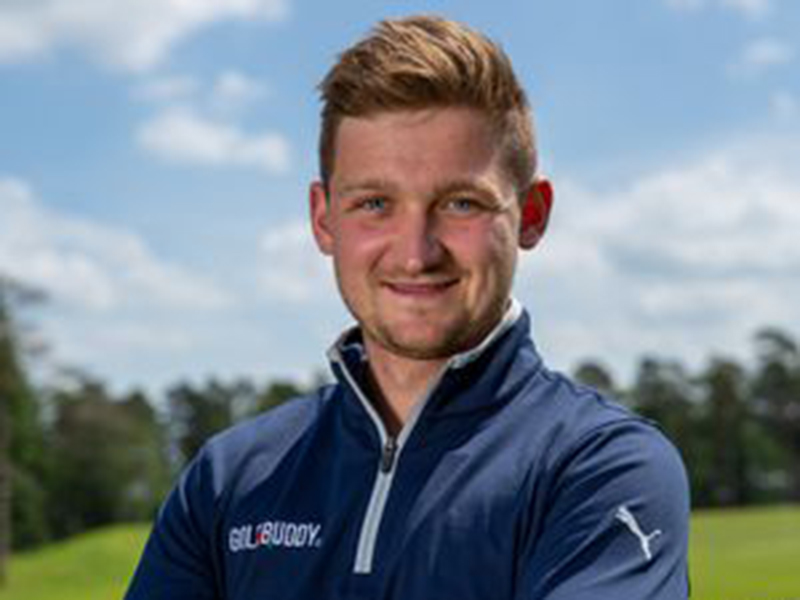
Alex spent three years caddying on the European Tour before taking his PGA qualifications. Since then he has created a thriving social media platform on Instagram and YouTube, where he offers a whole host of tips and advice to help viewers shoot lower scores.
Palms Facing
The putter grip is so individual to any golfer, but the rule that I like to have is grip in the palms and palms facing each other. This allows the club to be in a more neutral position. If you place the club in the fingers, and the palms are not facing, you might find that one hand becomes more dominant than the other. When putting, we want to feel as though our hands are working as a unit.
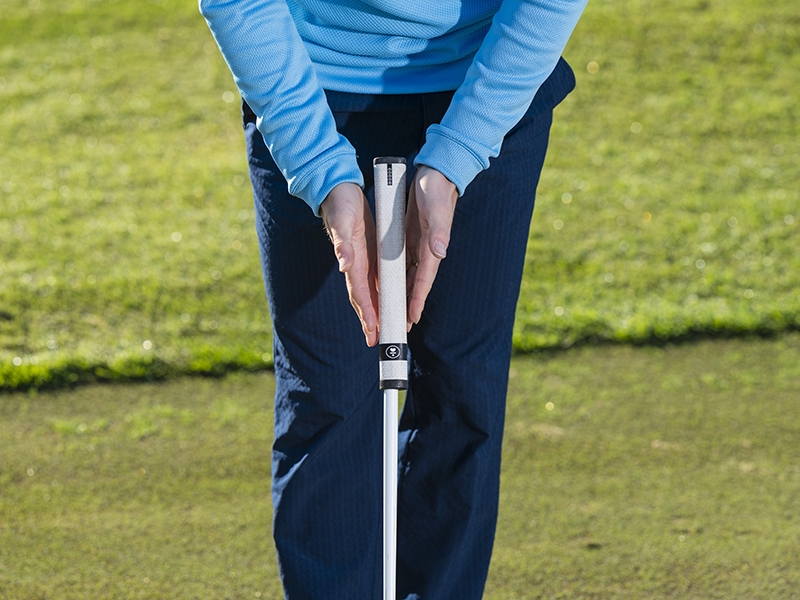
Ensure your palms are facing when gripping the putter as one hand may become too dominant
Ball Position
The correct ball position with a putter is one grip width ahead of your sternum. You can measure this when practicing or on the course, just as I am in the image below. It can be easy to get this wrong, as we often just go with what we feel is ‘middle’, which isn’t always accurate - so using a reference checkpoint like this is really useful.
The ball should be aligned with the middle of the pectoral muscle on your lead side. Having the ball forward of centre helps you to hit up on the ball, promoting a more consistent roll on the green.
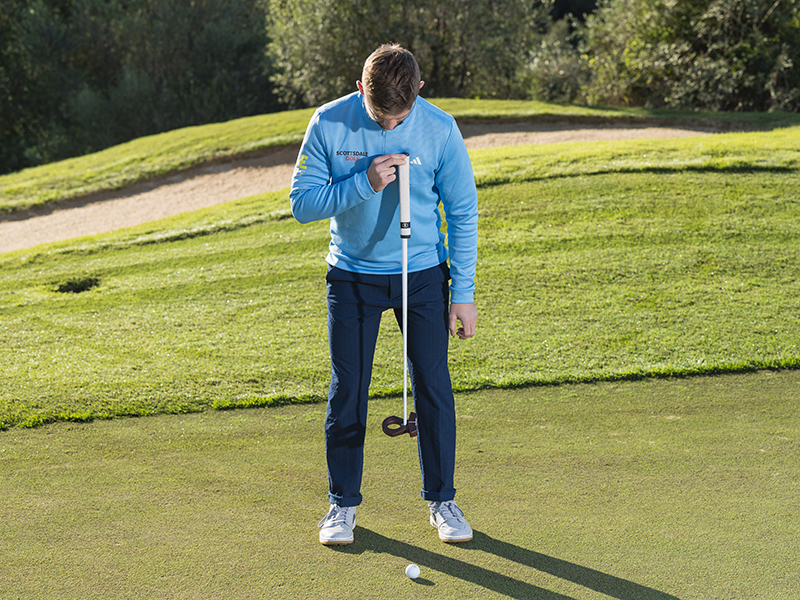
Ball position should be one putter grip width ahead of sternum
Elbows Tucked In
When putting, I want you to feel as though your elbows are tucked into the side of your body. This can also feel like your bicep and tricep are constantly in contact with your rib cage. This helps to keep everything connected, with all parts of your body working together for a consistent stroke.
Subscribe to the Golf Monthly newsletter to stay up to date with all the latest tour news, equipment news, reviews, head-to-heads and buyer’s guides from our team of experienced experts.
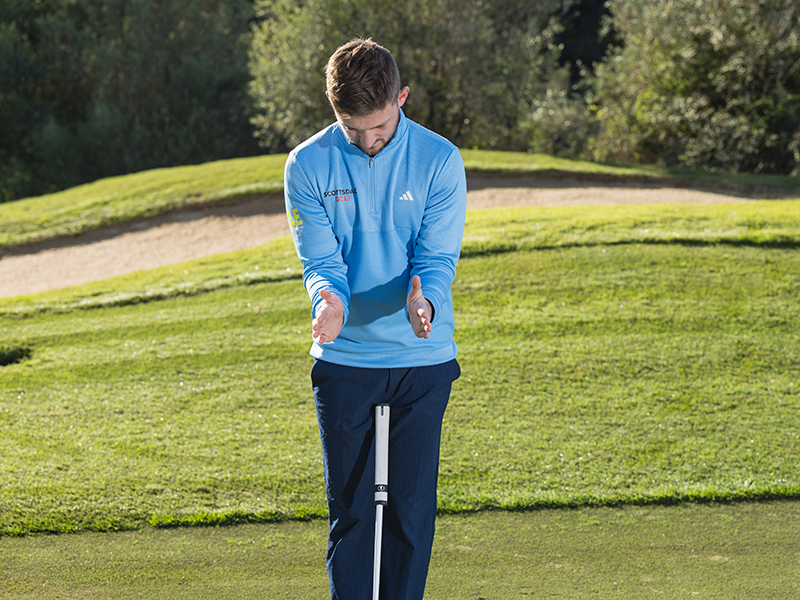
Feel like your elbows are touching your rib cage throughout the swing
Putting Stroke Drill
This is a great drill to improve that feeling of the elbows pinching into the side of the body when putting. Place a golf club under each armpit, and allow them to cross over like in an ‘X’ shape in front of you. Grip your putter as you normally would and hit a few putts towards a target. As you can see in the image below, you want to try to keep the middle of that cross (created by the two golf clubs) in the middle of your sternum throughout the swing.
This drill provides instant feedback, as if the elbows move away from the side of your body during the stroke, the two clubs will fall to the ground. If the wrist get too active and you start flicking at the ball, the middle of the cross won’t match up with the line of the grip on your putter. Using this drill will help you to find a consistent putting stroke and dial in your distance control.
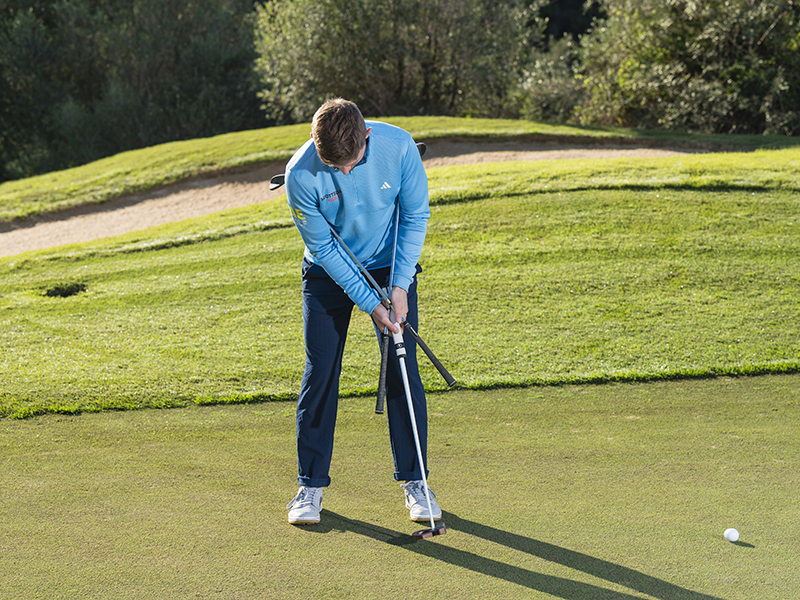
This drill provides immediate feedback and will improve your performances on the green
A photo posted by on
Neil Plimmer: Putting Principles And Posture
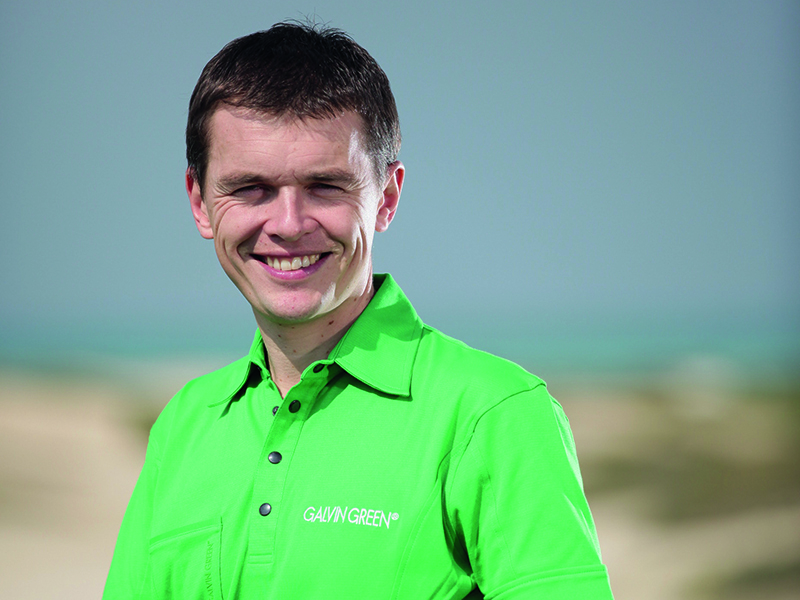
Neil has been a golf professional for over 20 years. He's joint owner of JOLF Ltd, which specialises in providing children and their families with opportunities to play golf, learn and compete in schools and at golf clubs.
Proper posture
One of the worst things you can see is when the putter head wavers and wobbles off line as you take it back. This will kill your confidence in the basic mechanics of the stroke, but the good news is that it’s often easily rectified.
Once you have set your spine angle and got yourself into your putting posture, make sure your elbows are connected to your midriff. From there let your arms hang naturally down. It amazes me how often I see amateurs pushing their hands away from them, or pulling them towards them at address.
Fighting gravity in this way is a battle you’ll always lose and it is the biggest cause of a wavering clubhead. So why not set up in front of a mirror at home and check that your arms are hanging naturally at address. A simple adjustment here could make all the difference.
Rotate, don’t rock

Rotate around your spine, rather than rocking your shoulders
It is one of the phrases you often hear coaches use, 'create momentum by rocking your shoulders back and forth’. For me, however, this thought provokes entirely the wrong move, as your elbows become disconnected from your body.
Instead, the way to think about it is to rotate your rib cage around your spine. Crucially, your arms need to be connected to your body, working together with this rotation.
Get it right and you’ll find the big muscles will take more control over the stroke, giving you the reliability and consistency you need.
Engage your chest and back muscles at address, and as long as your elbows are connected to your midriff, it will be the big muscles that dictate the length and speed of the stroke.
Stroke principles

Learning the five impact laws will help you diagnose faults
You might think it strange for me to say, but many of the same factors apply between your full swing and your putting stroke. The ball is on the ground and you are side on to your target, so you need to swing around yourself. The two differences are the length and the speed.
It is important therefore that you understand the five impact factors – the angle of the clubface, the swing path, the angle of attack, strike point and speed.
All you need to understand is that the direction the ball goes in when you putt is reliant on the same factors as your main swing. If you are consistently missing putts right it is possible the clubface is open to the target line at impact (just as it could be if you were pushing your drives).
My advice is to learn the five impact laws and then watch out for any trends in your putting - are you missing right or left regularly? - and use this information to get your stroke back on track.
Strike check

This drill will have you striking your putts consistently out the middle
To groove a consistent strike, build two gates using tees. Make the first gate just wider than the putter head, the second just wider than the ball and practise swinging the putter through the first gate to hit the ball through the second. Only with a pure strike will you achieve this.
Pace control
I have already talked about the importance of engaging the bigger muscles to control the swing. If you can do this then all you need to do to hit the ball further is make a slightly bigger swing, master it and you'll be far better at lag putting.
I often see players attempting to control the distance they hit the ball on the green through the speed of the stroke, but this will not deliver the best consistency. So engage the big muscles, turn around your spine and let the length of the stroke dictate distance.
FAQs
Q: What is the best way to practice putting?
A: Improving your understanding of green reading and distance control is the best way to reduce the number of putts you take in the each round.
A great drill to practice both elements would be to set up nine golf balls at random points on the practice putting green. Make your own scoring system, like every hole being a par-2, and set a target to beat. You can then track your progress over a number of sessions. Be sure to hit the putts in a random order, giving yourself time to read the break on each and time to understand the pace, as this will translate well to your experience on the course.
Q: How can I stop missing short putts?
A: The best way to avoid missing short putts is to work on three key fundamentals - rhythm, follow-through and the line of the putt. Ensure the tempo of your putt is consistent throughout, with no obvious accelerations. Your follow-through should be the same length as your backswing with putter, creating a pendulum effect, and be sure to read the line of the putt past the hole - trying to imagine that the hole is merely in the way on your decided line.

Baz joined Golf Monthly in January 2024, and now leads the instruction section across all platforms - including print and digital. Working closely with Golf Monthly's Top 50 Coaches, he aims to curate and share useful tips on every aspect of the game - helping amateurs of all abilities to play better golf. Baz also contributes weekly to the features section, sharing his thoughts on the game we love and the topics that matter most. A member at Sand Moor Golf Club in Leeds, he looks forward to getting out on the course at least once a week in the pursuit of a respectable handicap.
Baz is currently playing:
Driver: Benross Delta XT
3-Wood: Benross Delta XT
Hybrid: TaylorMade Stealth 4 Hybrid
Irons: Benross Delta XT 5-PW
Wedges: TaylorMade RAC 60, Callaway Jaws MD5 54
Putter: TaylorMade Spider Tour
- Neil PlimmerTop 50 Coach
- Alex ElliottTop 50 Coach